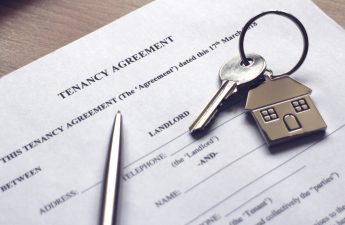Using a thorough tenant move-in checklist can reduce vacancy and repair costs by speeding up turnover and making sure outgoing tenants pay for whatever damage they’ve done. Estimates of the cost of rental unit turnovers range from $1-5000 per vacancy. Effectively managing the process of transitioning from one tenant to the next can mean a huge increase in the profitability of your rental property. If you don’t already use a tenant move in inspection checklist, we highly recommend you start. In this article, we’ll discuss why and how to do move-in inspections with new tenants.
Above all, when moving in a new tenant you want your property to be attractive and in good condition. By consistently documenting the condition of the rental at move-in, inspecting the property when a tenant gives notice, and scheduling repairs for the earliest possible date — possibly even before move-out — you can make the difference between good and great return on your investment.
Top maintenance items at rental turnover
- General cleanliness
- Carpet stains and damage
- Paint condition and holes in walls
- Damaged flooring
- Condition of appliances
- Functionality of drains and plumbing fixtures
Related Topics: Top credit screening services for landlords, and Collect rent online: 8 tips to choosing the best service
What will a tenant move-in checklist do for you?
- Protect both landlords and tenants by documenting the condition of a unit.
- Help ensure quick turnovers, by setting up tenants to leave their rentals in good condition — thus minimizing money lost due to vacancy. You might consider providing them with a tenant turnover checklist so they are clear how they need to leave the unit when they move out.
- Minimize expenses by ensuring tenants pay for damage they’ve done to your property.
- Help make turnover smooth and fast, saving you time in negotiating with tenants and coordinating repairs.
- Help avoid conflicts, including legal battles, where a tenant claims damage was done before they moved in.
- Communicate your expectations about how the tenant should leave the apartment in order to have their deposit refunded.
- Show tenants that you care about the condition of the property, and will be paying attention to how they treat it.
- Provide an inventory of fixtures, appliances, and other features of the unit.
- Set expectations for what you will consider damage versus normal wear-and-tear.
Tips for using a tenant move-in checklist
- Have your new resident fill out the apartment turnover checklist.
- Make sure to fill out the condition report while both you and the new tenant are in the unit. (I’ve been lazy about this in the past, opting to allow them to fill it out during move-in. This is appealing so that I don’t have to stand around while a tenant inspects the property, however it’s sloppy policy as it leaves room for dispute. I’ve reformed my ways!)
- Filling out a tenant move-in checklist gives new residents a sense of responsibility for maintaining the property in the condition in which they receive it. By giving tenants license to document as much as they need to you can help them feel safe, as they can feel confident there won’t be charges for pre-existing damage at move-out.
- Review the condition report with tenants & negotiate any differences in opinion.
- Share your approach to tracking the condition of a unit, explaining what you see as damage.
- Discuss how you treat the return of security deposits. Tenants are highly motivated to have their entire deposit refunded quickly. Communicate your expectations clearly and most will leave the rental in good condition.
- Have the new tenant move-in checklist filled out before you hand-over keys, and definitely before move-in. (Again, I’ve been lazy – but no more!)
- Fill out the checklist at the same time you sign the lease with a new tenant so that you don’t get into a situation where a lease has been signed, payment made, and you hit an impasse. Record the condition of the unit and make the checklist part of the formal rental agreement.
Software products can help streamline the inspection process
Several software providers offer products to make the tenant move-in inspection process fast, easy, and official. The best property management inspection software is usually part of an app, which speeds up completion of the move-in condition checklist. These apps are great tools at move-out and for periodic inspections as well, allowing you to track the condition of the rental.
Related topic: Property Management Software products, and the best reasons to use them.
Advantages of an app-based tenant move-in checklist
- Room-by-room a new tenant can easily record the condition of each element of the rental.
- Take photos of existing conditions. When a tenant is moving out you can compare with these against the conditions at that time, allowing you to charge tenants for damages they’ve done during tenancy.
- Many apps allow e-signing, creating an instant and official shared record of the property condition.
- *Note: Make sure the format and thoroughness of the inspection checklist complies with local laws.
Rental inspection software tools and apps to consider
Many inspection tools are features of full-service property management software solutions. Here are a few we recommend reviewing:
Best for small landlords
zInspector: Offers a free entry-level subscription for up to 5 units, with pricing starting at $22/mo for more units. zInspector offers a wide variety of customizable inspection templates as well as photo and video features and e-signing. The interface is fairly basic, not as elegant as others. Higher-level subscriptions also offer more forms of reporting, and integration with software products such as RentecDirect and Appfolio.
Pendo: Pendo is a full-service property management software product, which also offers property inspection functionality via their app. Subscription levels are $10/mo for up to 5 units and $30/mo for 5-100 units, both levels offer the inspection tool. Allows the addition of photos & video to the inspection report. The document can be shared and signed by all parties.
PropertyInspect: Looks like a robust, user-friendly, and full-feature product with support for multiple properties. Subscriptions start at $37/mo, which gets you 100 units but only one user.
Best for larger portfolios
Buildium: Buildium partners with HappyCo to provide a property inspection app that offers move-in, move-out, and periodic inspections. The product appears very thorough and easy to use. Pricing requires a Buildium subscription which starts at $55/mo and goes up depending on number of units. The inspection feature costs an additional $40/mo, plus a $99 setup fee. This product is best for landlords or property managers with a medium-to-large portfolio.
Chapps: This product appears to cater to larger property managers. Reports look to be very complete, and easy to use. Provides maintenance tracking and planning functions. Multiple parties can share this data. As a result of the fact that pricing is based on the number of units under management, it is only available by request. I have, however, seen reviews that list a price of $4.99/report.
Rentec Direct: Offers a comprehensive set of property management features. As a way of offering additional value, Rentec allows users to sign up for a zInspector account separately, making the documented condition part of the unit profile. Rentec Direct subscriptions start at $45/mo.
Disclosure: Some of the links in this post are affiliate links and Landlord Gurus may earn a commission. Our mission remains to provide valuable resources and information that helps landlords manage their rental properties efficiently and profitably. We link to these companies and their products because of their quality, not because of the commission.




